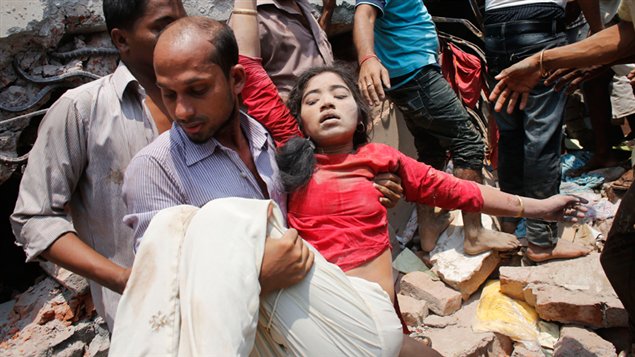It was a nasty shock for some Canadians to realize some of their clothing may have been made in the Bangladesh factory that collapsed last week killing almost 400 garment workers.

A picture of clothing tagged Joe Fresh in the rubble brought it home. That brand of very inexpensive clothing is sold in the Loblaw chain of stores across the country.
Consumers expressed their shock prompting several Canadian retailers including Loblaw to call a meeting today with the Retail Council of Canada to talk about working conditions in developing world sweatshops.
Canadians concerned, survey shows
Eight in ten Canadians said they wanted to make an effort to ensure they know how and where the products they buy are made, according to a survey commissioned by World Vision Canada last summer. Child labour was the poll’s main focus but this humanitarian agency says the results indicate a more general concern among Canadians about working conditions in the developing world.
68 per cent of respondents said they would spend an average of 16 per cent more on a product if there was a guarantee it were free of child labour. Half said they had gone out of their way to buy a fair trade product or products free of child labour. But 78% have no idea if what they are buying contributes to the exploitation of children.

“We (Canadians) are concerned that our desire for low-cost items may have an impact on people in countries that we don’t know,” said Cheryl Hotchkiss, manager of World Vision’s End Child Slavery campaign. “One of the things World Vision is concerned about is that we don’t have enough information as Canadians about where our products come from and that we want companies to be providing that information to us.”
Canadians have responded to a World Vision campaign about ethically produced chocolate. “As soon as you tell Canadians where this product comes from and that it might involve child labour they immediately want to know where they can buy products that are free from child labour,” says Hotchkiss. She is also encouraged by the fact that many Canadians access the agency’s online Shop for Change guide which helps identify ethical products.
Corporations are not looking carefully enough at their supply chains asserts Hotchkiss, at least not until there is a crisis. Products with the Fair Trade Certified Logo or the Rainforest Alliance Certified logo are fairly certain to have been made ethically, she believes. However she laments the fact that so few products carry them.
Consumers should ask hard questions, says World Vision
“That doesn’t limit you (the consumer) to taking the next step and writing to that company or manufacturer and saying ‘can you tell me more about where this product comes from. What is your code of conduct?’” Many companies have Facebook pages which consumers can use to ask such questions, says Hotchkiss.
World Vision is urging government and corporations to look at supply chains and find the best way to assure transparency so people know how products are not only made, but how the materials they use are produced. The agency makes an example of cotton which is sometimes grown and harvested by children.







For reasons beyond our control, and for an undetermined period of time, our comment section is now closed. However, our social networks remain open to your contributions.